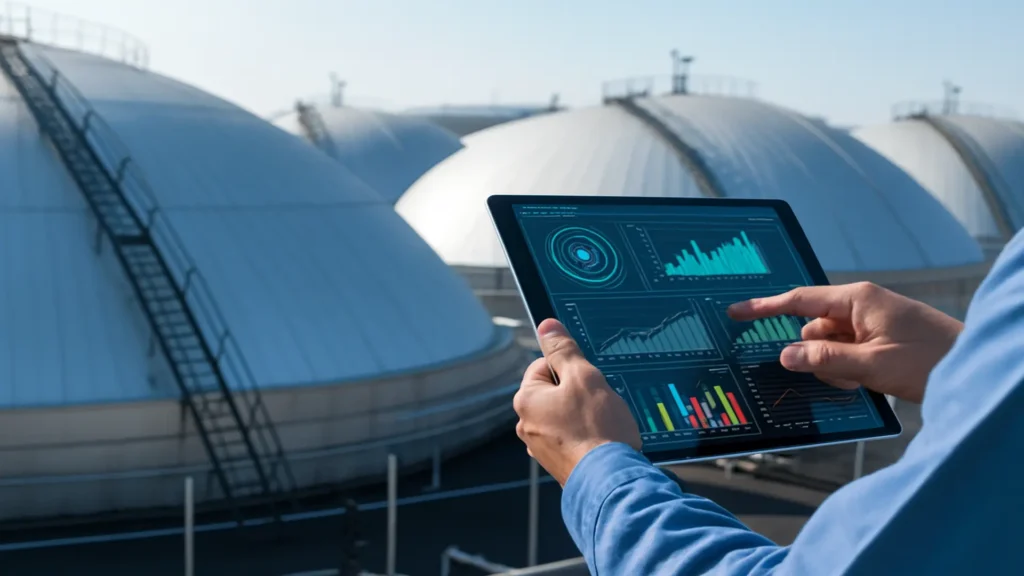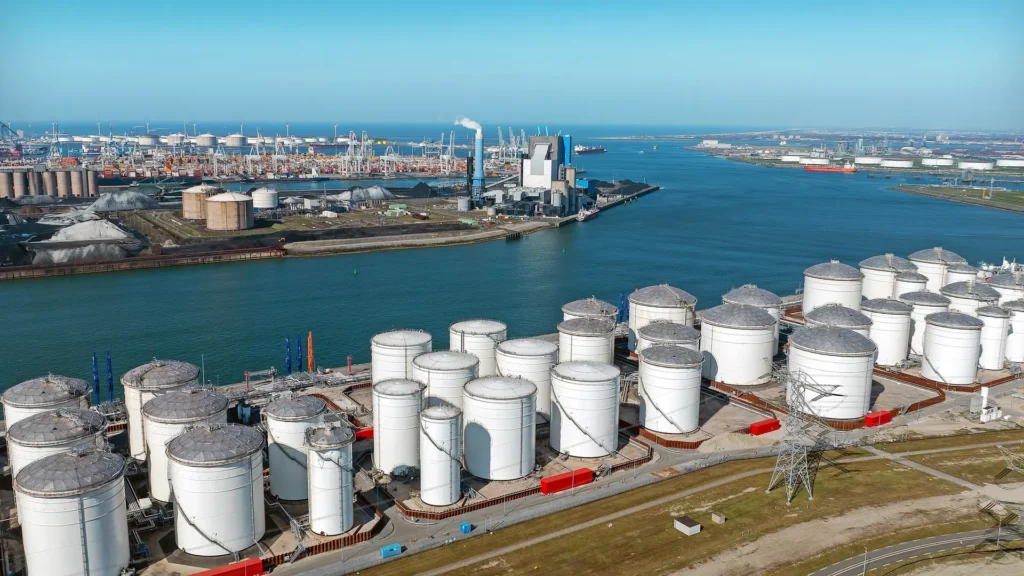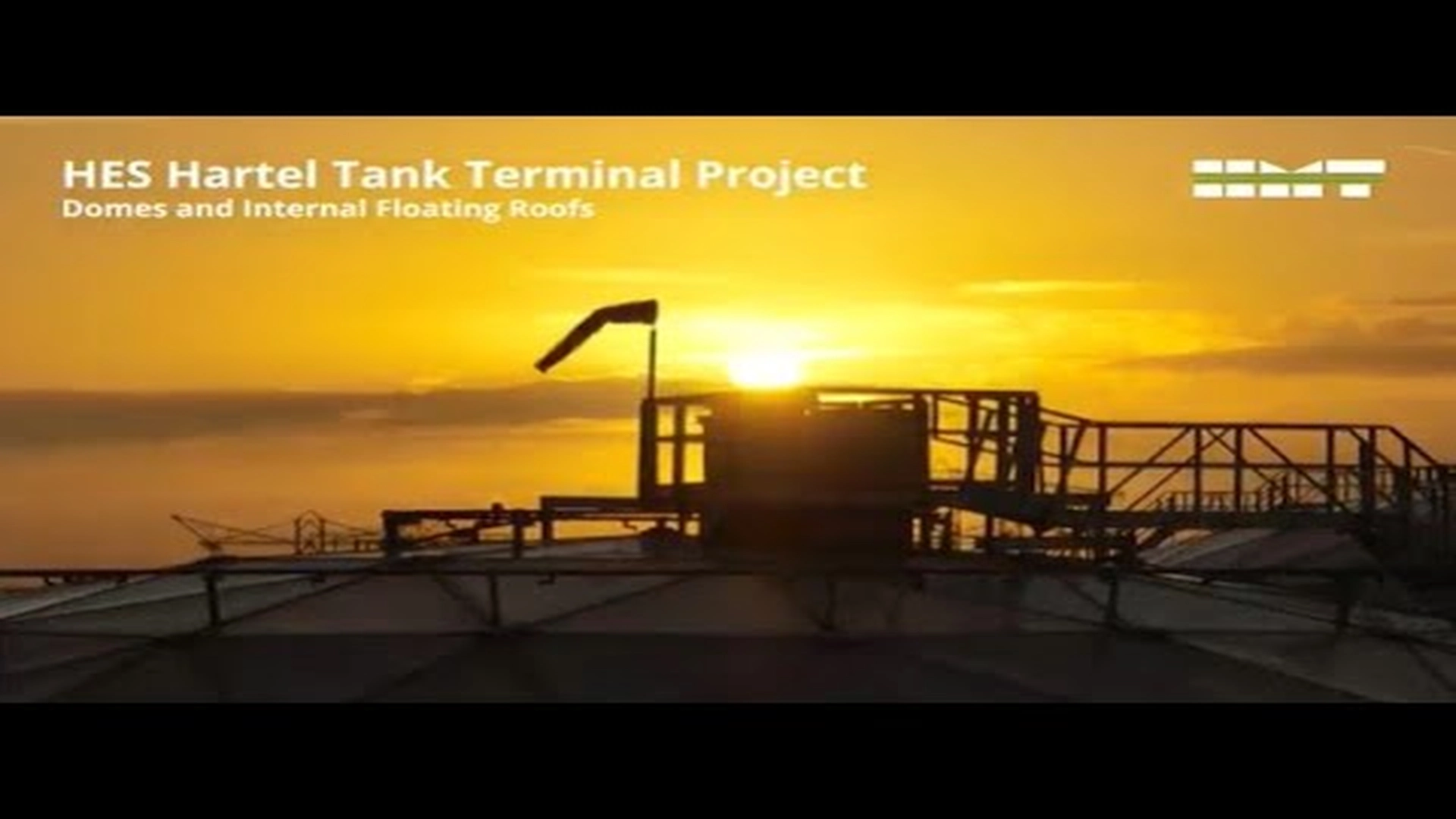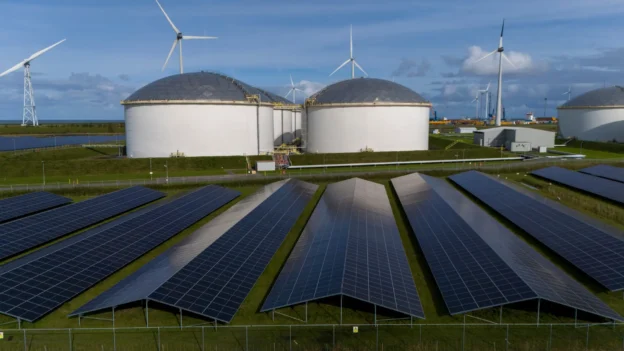Table of Contents
- The green transition in storage terminals
- Challenges of Blended Fuels on Existing Infrastructure
- The science of emission control
- Technological innovations to reduce VOCs
- Digitalization and predictive environmental management
- Operational strategies for sustainable terminals
- Conclusion
- References
- (FAQ): Sustainability and AST fuel emissions control
Across the global energy landscape, storage terminals are undergoing one of the most profound transformations in their history. Environmental regulations from agencies such as the U.S. Environmental Protection Agency (EPA) and the Texas Commission on Environmental Quality (TCEQ) have become increasingly strict, especially regarding volatile organic compound (VOC) emissions and spill prevention. At the same time, decarbonization goals and sustainability commitments from governments and private industries are reshaping how fuels are stored, monitored, and delivered.
For terminal operators, this transition represents a dual challenge: maintaining operational efficiency while reducing their environmental footprint. The shift toward cleaner storage systems requires not only technological modernization but also a change in mindset, where sustainability becomes an integral part of terminal management and operational strategy.
The National Institute for Storage Tank Management (NISTM) has played a key role in promoting knowledge exchange and best practices that help the industry meet these new environmental and performance standards. In this changing context, sustainability and emission control have emerged as defining pillars for the future of fuel storage management.
The green transition in storage terminals
Environmental pressures and regulatory evolution
In recent years, environmental oversight of aboveground storage tanks (ASTs) has expanded in both scope and enforcement. Regulations such as EPA 40 CFR Part 60 (Subpart Kb) and TCEQ Chapter 115 have established more rigorous requirements for monitoring, controlling, and reporting VOC emissions. These frameworks directly influence how operators manage seals, floating roofs, venting systems, vapor recovery units (VRUs), and spill prevention systems designed to minimize product losses and soil contamination.
Beyond compliance, there is growing alignment with global decarbonization targets and corporate ESG (Environmental, Social, and Governance) standards. Investors, regulators, and communities increasingly expect energy companies to demonstrate transparent sustainability strategies. As a result, emission control has evolved from a technical obligation into a core performance metric, shaping investment decisions and operational design across the sector.
This new regulatory and financial environment is accelerating innovation. Terminal operators are turning to digital monitoring systems, low-permeability materials, and predictive analytics to ensure compliance while maintaining cost efficiency and operational reliability within modern terminal management frameworks.
The new role of terminals in energy Transition
Modern storage terminals are no longer static infrastructure; they are becoming active enablers of the energy transition. Across North America and beyond, facilities are being reconfigured to handle biofuels, hydrogen blends, and synthetic fuels, which differ significantly from traditional hydrocarbons in terms of volatility, material compatibility, and corrosion behavior. These shifts demand new containment strategies and real-time integrity monitoring to maintain safety and environmental performance.
Forward-looking operators are integrating digital twins, advanced sensors, and machine-learning models to track emissions, anticipate material degradation, and optimize operational schedules. By linking sustainability with performance, terminals are redefining their role within the energy value chain—from fuel storage sites to smart, adaptive systems that support cleaner logistics and long-term reliability.
Challenges of Blended Fuels on Existing Infrastructure
Adapting existing infrastructure to accommodate new fuel blends poses technical and operational challenges. Biofuels, for instance, can introduce higher moisture content and microbial activity, leading to accelerated corrosion or seal degradation. Hydrogen and synthetic fuels may increase vapor pressure or affect material integrity. Addressing these issues requires meticulous engineering analysis, corrosion modeling, and updated emission-control technologies.
While these challenges are significant, they also open new opportunities for innovation. Companies that choose to upgrade their systems today by implementing enhanced monitoring, selecting compatible materials, and adopting predictive maintenance practices are ensuring full compliance with environmental standards. At the same time, they are strengthening the long-term resilience of their operations and preparing for the evolving demands of sustainable energy storage.
The science of emission control
Main sources of emissions in ASTs
Every aboveground storage tank (AST) releases vapors through physical and chemical processes that occur during normal operations, making real-time monitoring essential to identify emission fluctuations as they happen. The three main categories of losses are known as working, breathing, and standing losses. Working losses happen when the liquid level inside the tank changes due to filling or withdrawal, which causes vapor displacement.
Breathing losses result from temperature and pressure fluctuations that expand and contract the vapor space above the liquid surface. Standing losses occur even when the tank is idle, mainly through small imperfections, corroded surfaces, or degraded seals.
The most common emission points include floating roofs, seals, vents, and corroded areas on the shell or roof plates. Even minor deterioration in these components can release significant quantities of volatile organic compounds (VOCs) into the atmosphere over time, making the use of protective coatings essential to prevent surface degradation and vapor escape. As regulatory pressure increases, understanding the source and dynamics of these emissions becomes essential to maintaining compliance and environmental integrity.
Technological innovations to reduce VOCs
Recent advancements in emission-control technology and IIoT sensors are helping terminal operators manage VOCs more effectively. The use of advanced floating-roof seals minimizes vapor escape by improving flexibility and reducing wear from mechanical stress and chemical exposure. Protective coatings and secondary containment systems add an extra layer of protection, extending the life of steel components and reducing corrosion-related emissions while contributing to spill prevention by maintaining structural integrity under stress or impact.
Another major innovation is the deployment of vapor-recovery and vapor-combustion units (VRUs and VCUs) that capture and process hydrocarbon vapors instead of releasing them. These systems are now being complemented by real-time monitoring and IIoT sensors integrated into advanced Industrial Internet of Things networks for continuous leak detection and data capture. These sensors continuously monitor pressure, temperature, and gas concentration, providing early warnings of abnormal conditions.

Success stories: Digital monitoring and structural innovation
Gulf of Mexico: VOC reduction through digital monitoring
At a large fuel storage facility on the Gulf Coast, a network of IIoT sensors detected an unexpected rise in vapor concentration within one of the floating-roof tanks. The system’s predictive algorithm identified the trend before it reached the emission threshold, allowing maintenance teams to inspect and repair a worn primary seal.
The corrective action prevented a potential VOC release, demonstrating how real-time monitoring can transform emission management from a reactive to a preventive process.
Europe: Structural innovation and emissions control
An additional example of best practices in sustainability and emission reduction is represented by the project developed by HMT LLC at the HES Hartel Tank Terminal, located in the Port of Rotterdam, the Netherlands. This state-of-the-art terminal was designed for the storage of clean fuels under one of the most demanding regulatory environments in the world.

The project involved the installation of 54 internal floating roofs, 46 aluminum geodesic domes, and advanced sealing systems that significantly reduce the release of volatile organic compounds (VOCs). These solutions were designed to meet strict environmental and safety standards, ensuring reliable operation with minimal emissions.
We offered industry-leading technology through geodesic domes, full-contact aluminum floating roofs, and sealing systems designed to minimize emissions from these tanks.
HMT LLC team
This case demonstrates how structural innovation and advanced engineering design can complement digital monitoring strategies, contributing to more robust and sustainable environmental management at fuel storage terminals.
Watch this case, courtesy of HMT LLC: HES Hartel Tank Terminal Project (Rotterdam)

HES Hartel Tank Terminal Project.
Digitalization and predictive environmental management
Digital twins and real time emissions monitoring
The integration of digital twins into environmental management is redefining how terminal management teams monitor emissions, optimize performance, and anticipate maintenance needs. A digital twin is a virtual replica of a physical asset that simulates its behavior under real operating conditions. By synchronizing data from IIoT sensors with computational models, operators can visualize tank performance through real-time monitoring, detect deviations, and optimize venting cycles to minimize vapor losses.
These virtual models also make it possible to predict the effects of temperature fluctuations, liquid movement, and material degradation on emission behavior. Through continuous feedback loops, the system updates its calculations based on live data, allowing managers to take corrective action before emissions exceed regulatory limits.
Thanks to integration with IIoT networks, this supervision extends to multiple tanks and process lines, ensuring continuous monitoring of environmental performance and immediate reaction to any operational deviations.
Integration of RBI models into risk issue correlation
When digital twins are linked with Risk-Based Inspection (RBI) models, they create a powerful tool for correlating emission trends with structural integrity risks. This integration helps engineers determine whether an increase in emissions is caused by operational factors or by developing defects such as corrosion or seal wear. The result is a holistic understanding of environmental performance that supports both safety and sustainability objectives.
Data analytics and AI for sustainable operations
Predictive analytics and artificial intelligence (AI) are becoming cornerstones of modern emissions management strategies. These technologies process large volumes of data collected by Industrial Internet of Things (IIoT) sensors distributed across tanks, pipelines, and control systems. By identifying early patterns that indicate leaks, overpressure conditions, or equipment fatigue, AI enables faster interventions and a significant reduction in environmental impact.
Cloud-based dashboards allow environmental teams to visualize key performance indicators (KPIs) such as VOC concentration trends, pressure stability, and carbon equivalent savings. Integrating these data streams promotes transparency and accountability across the organization.
The direct connection between IIoT sensors and cloud platforms optimizes information traceability, allowing real-time variations to be recorded, improving energy efficiency, and ensuring more accurate emissions control. By transforming raw information into actionable insights, data-driven decision-making ensures that sustainability goals are not only documented but actually achieved.
Operational strategies for sustainable terminals
Mantenimiento preventivo y recubrimientos protectores
One of the most effective ways to minimize emissions in storage terminals begins with preventing corrosion. Modern facilities rely on high-performance protective coatings and cathodic protection (CP) systems that create an electrochemical barrier against material degradation, minimizing corrosion and emissions. By reducing corrosion rates on tank bottoms, roofs, and piping, operators extend equipment life and reduce the likelihood of leaks, vapor losses, or accidental releases, strengthening their spill prevention programs.
Advanced protective coatings such as epoxy, polyurethane, and ceramic systems now offer higher chemical resistance and durability in aggressive environments. When combined with continuous monitoring of CP systems, these solutions maintain the structural integrity of steel components and significantly decrease the volume of volatile compounds released into the atmosphere.
Preventive maintenance programs based on condition data and predictive analytics allow engineers to schedule interventions before corrosion leads to measurable emissions, turning maintenance into a key pillar of sustainability.
Training and organizational culture
Technology such as IIoT sensors and real-time monitoring systems cannot achieve sustainability on their own. People remain the most important factor in the pursuit of cleaner operations. Effective environmental management depends on well-trained personnel who understand how their actions influence emissions, safety, and regulatory compliance.
Progressive terminal operators are investing in training programs that focus on emission awareness, emergency response, and ethical responsibility toward the environment. Building this culture of accountability transforms sustainability from a corporate slogan into daily behavior across all levels of terminal management. When operators recognize the environmental impact of each valve adjustment, product transfer, or maintenance task, they become active contributors to emission reduction. A strong organizational culture ensures that every employee participates in protecting both assets and the surrounding ecosystem.
Future prospects: Towards zero emission terminals
The future of fuel storage is moving toward net-zero operations, driven by a combination of innovation, policy, and public expectation. Terminals are beginning to integrate renewable energy sources such as solar and wind power to operate pumps and monitoring systems. Electrified pumping units are replacing conventional motors, cutting fuel consumption and indirect emissions.
Artificial intelligence is being used to optimize vent control and vapor recovery, ensuring that storage tanks breathe only when necessary. Circular systems are emerging as well, where recovered vapors and waste streams are reprocessed into usable energy. Within this framework, the National Institute for Storage Tank Management (NISTM) continues to promote research and technical collaboration that encourage the development of next-generation zero-emission storage terminals. The path forward is clear: sustainable infrastructure will define competitiveness in the decades ahead.
Conclusion
Sustainability in terminal management has evolved from a regulatory requirement into a strategic necessity. Cleaner operations now represent efficiency, reliability, and corporate responsibility. Achieving these goals requires more than technology; it demands a balanced integration of innovation, regulation, and culture.
At Inspenet, we believe that the collaboration between engineers, regulators, and organizations like NISTM will accelerate the transition toward emission-free storage systems. The future belongs to those who align environmental stewardship with operational excellence.
Learn more about the innovations that will define the next generation of sustainable storage terminals with Inspenet and the National Institute for Storage Tank Management (NISTM).
References
- Jindamanee, K., Keawboonchu, J., Pinthong, N., Meeyai, A., Inchai, P. et al. Environmental impacts and emission profiles of volatile organic compounds from petroleum refineries. Scientific Reports, 15 (2025), Article 15509. https://www.nature.com/articles/s41598-025-99932-7
- Peng, J. et al. A review of emission characteristics and risk assessments of VOCs in the petrochemical industry. Journal of Cleaner Production, (2024). https://www.sciencedirect.com/science/article/abs/pii/S0269749124022930
- Lv, D., et al. Source profiles, emission factors and associated health risks of volatile organic compounds from storage tanks. Science of The Total Environment, (2021). https://www.sciencedirect.com/science/article/abs/pii/S0269749121001676
- Holkar, A., Gujar, J. G., Sonawane, S. S., Jadhav, A. Assessing emission and reduction strategies for volatile organic compounds (VOCs) in refinery. Journal of Indian Association for Environmental Management, Vol 43 No 3 (2023). https://or.niscpr.res.in/index.php/JIAEM/article/view/4057
- Lee, H. E., Yoon, S. J., Kim, J. H. Analysis of VOC emission characteristics in the petrochemical industry and study on fenceline monitoring techniques. Atmosphere, 16 (5) 543 (2025). https://www.mdpi.com/2073-4433/16/5/543
(FAQ): Sustainability and AST fuel emissions control
Why are VOC emissions in tanks critical?
Aboveground storage tanks (ASTs) release vapors during normal operations such as filling, emptying, thermal expansion, and idle periods. These emissions can be significant, posing health, environmental, and regulatory risks.
What technologies reduce VOC emissions in terminals?
Key technologies include floating roofs with advanced seals, aluminum domes, vapor recovery units (VRU/VCU), IIoT sensors for early leak detection, and digital twins for predictive tank monitoring.
How do biofuels and hydrogen affect storage tanks?
These new blends can alter vapor pressure, humidity, or microbial activity, affect sealing materials, or accelerate corrosion. This requires engineering analysis, compatible materials, and adapted preventive maintenance programs.
Why does digitalization improve emission management?
Digital tools enable a shift from reactive to preventive approaches: continuous monitoring, early anomaly detection, prediction of failures or degradation, optimization of maintenance schedules, and indirectly, reduction of emissions and operational costs.
What regulations control emissions in U.S. terminals?
Key regulations include 40 CFR Part 60 Subpart Kb (EPA) and TCEQ Chapter 115 (Texas Commission on Environmental Quality), which establish stricter requirements for monitoring, controlling, and reporting VOC emissions from ASTs.

